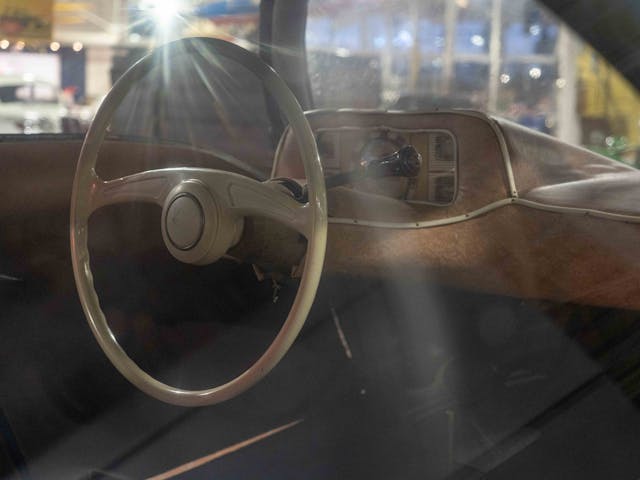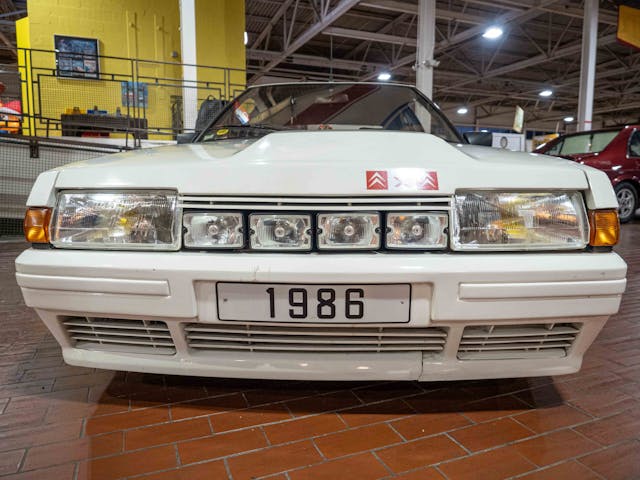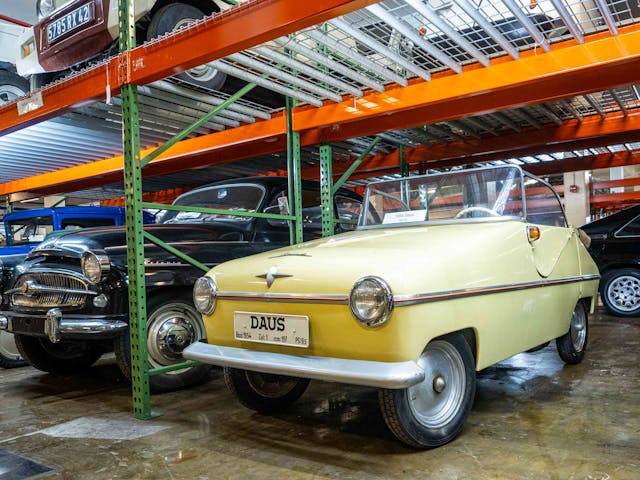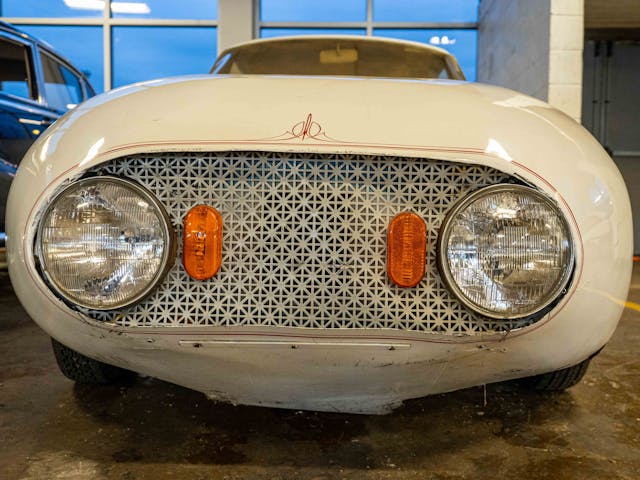The title of this story is overkill, honestly, because there are no normal cars at the Lane Motor Museum. The entire 132,000-square-foot facility, housed in the former Sunbeam Bakery in southeast Nashville, is an automotive funhouse—two floors of the weird and wonderful, the fantastic fringe of the mechanical world.
Collector Jeff Lane opened the place more than 20 years ago, using his own 70-car collection to anchor it, and it has since grown to house nearly 600 cars, with about 150 on display on the main floor and the rest stored in the basement “vault,” which is opened up for guided tours on the weekends. For the most part, every car in the museum is a runner, and a rotating maintenance schedule helps to keep them that way.
Now, with such a vast collection of weird little (and big) machines, it’s impossible to state which are the oddest. No two lists will ever be the same. That said, during my recent visit to this wonderful place, these eight caught my eye.
Upstairs . . .
1952 Future

The museum has no shortage of one-offs, but the Future—brainchild of Sigvard Berggren—may be one of the coolest. The Swede constructed a steel tube frame atop the chassis of a 1938 Dodge seven-passenger sedan, formed the steel body panels by hand, and plunked a 239-cid flathead Ford down in the middle to power his wild creation. It garnered significant press in the early 1950s, but it was not long before Berggren had moved on to other things—namely wildlife conservation in Africa—and the Future never made it out of the present. Or is it the past?



1974 Citroën DS20 Break Ambulance Civile


The Lane Museum is home to more than 40 Citroëns, and this DS20 is the very first car you encounter when you set foot in the main room. With a production run spanning 20 years (1955–75), the funky DS appeared in both sedan and wagon body styles, plus a rare two-door convertible. The livery of this DS ambulance was commissioned by the son of the former owner, who was so moved by the events of September 11, 2001, that he had the car painted in the Stars and Stripes to pay tribute.
1986 Citroën BX4TC

Another of the Lane’s many Citroëns, this BX4TC represents the French carmaker’s highly unsuccessful attempt to break into Group B rallying. This homologation special is one of 86 built and differs from your standard Bertone-styled BX—of which more than 2.5 million were made—in a couple of important ways: Namely, it’s equipped with four-wheel-drive, and the nose is elongated to accommodate a 200-hp, turbocharged 2.0-liter Peugeot four-cylinder mounted longitudinally in the engine bay. The BX4TC only competed in three rallies before Group B was canned, its best finish a sixth place at the 1986 Swedish Rally.



2015 Nissan GT-R LM NISMO

Nissan has a long, proud history in motorsport, and over the years the Japanese carmaker has shown it is not afraid to take risks. There was the Deltawing of 2012, for example. And then there’s this guy, Nissan’s attempted entry into the World Endurance Championship. In our modern motorsport world, with its proven formula of mid-mounted engines driving the rear wheels, this GT-R LM was conceived as a front-engine, front-wheel-drive hybrid. As such, it sports front tires that are 14 inches wide, with 9-inchers in the rear. Power comes from a Cosworth-built twin-turbocharged 3.0-liter V-6 making 500 horsepower, and paired with the onboard kinetic energy recovery system (KERS), output was claimed to be 1600 hp in total. Alas, the car’s complexity and the limited timeframe to make it competitive meant that it simply wasn’t. Three cars were fielded at Le Mans in 2015; two retired with mechanical issues and the third finished but was not classified. Nissan pulled the plug on the program in December of that year.


Downstairs . . .

1946 Hewson Rocket

Not to be confused with that famous Texas basketball team, the shiny little Hewson Rocket was the brainchild of William “Shem” Hewson, who in 1945 created the Hewson Pacific Corp. with plans to produce and sell his weird machines for $1000. He engaged Coachcraft Ltd. of Hollywood, which plied its trade making custom cars for wealthy clientele, to build the slippery aluminum body. However, Hewson ran out of money right around the time this first and only car was completed, so it never achieved the success to match those great Houston Rockets teams of the 1990s.


1954 Daus


Automotive history is littered with dreamers who worked up the gumption to build their own cars. German Otto Daus was such a dreamer, and armed with a background designing three-wheeled trucklets prior to WWII, he applied his skills in 1954 to this prototype, which remains the only Daus car ever built. It is powered by an air-cooled two-stroke 197-cc single producing 9.5 horsepower, enough to propel this little yellow fellow to 45 mph.
1961 Futura/Waimea

In 1946, a year after he and Joseph Frazer created the Kaiser-Frazer auto company, Henry J. Kaiser founded Kaiser Aluminum. To promote his new metal business, Kaiser asked industrial designers Rhys Miller and Frank Hershey to dream up some wild illustrations of aluminum-bodied car concepts he could sell to the auto industry. The sales never came, but the portfolio of ads remained, and in the mid-1990s, Minnesota car restorer Blake Larson took inspiration from one Miller design in particular: the Waimea. Then he built it. With a required central driving position, Larson based the car on a rear-engine Corvair Lakewood wagon, but the machine is a buffet of pieces and parts from elsewhere, with a Ford Skyliner sunroof, Cadillac taillights, Nash gauges, and a Vega roof rack. And, of course, the script from a Ford Falcon Futura.
1972 Honda N600 Hyper-Miler

Following a long, successful courtship through its motorcycles, in 1970, the N600 became Honda’s automotive introduction to the U.S. market. Based on the Japanese-market N360, the front-wheel-drive N600’s 32-hp, 600-cc two-cylinder engine was highly efficient, moving the 1350-pound, sub-10-foot car to the tune of around 40 mpg. Not much is known of this N600 “Hyper Mileage” example, though with its ridiculous grafted-on fiberglass proboscis and swooping elongated tail, it’s not hard to believe the proclamation painted on the side.


Read More
Review / Nelson Rigg Quick-Release Saddlebag Plates
Recapping the FIM Junior GP, ETC, Stock ECh and Moto2 action from Estoril finale
They Were Stuck in a Tornado But Survived Because of One Critical Factor



